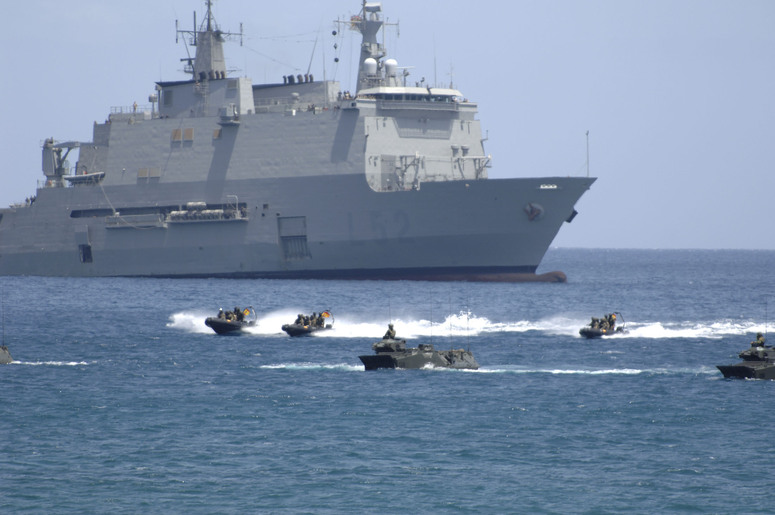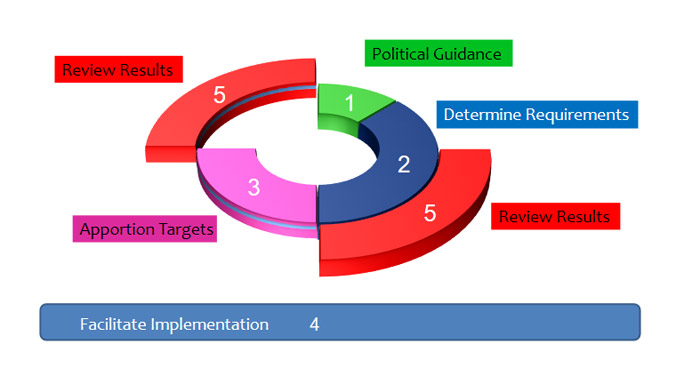NATO Defence Planning Process
The aim of the NATO Defence Planning Process (NDPP) is to provide a framework within which national and Alliance defence planning activities can be harmonised to enable Allies to provide the required forces and capabilities in the most effective way. It should facilitate the timely identification, development and delivery of the necessary range of forces that are interoperable and adequately prepared, equipped, trained and supported, as well as the associated military and non-military capabilities, to undertake the Alliance’s full spectrum of missions.

- Through the NDPP, NATO identifies the capabilities that it requires, and promotes their development and acquisition by Allies.
- The NDPP provides a framework within which Allies harmonise their national defence plans with those of NATO, without compromising their national sovereignty.
- The NDPP apportions requirements to each Ally as Capability Targets on the basis of a fair share of the overall requirement, facilitates their implementation and regularly assesses progress.
- Allies are committed to ensuring that their national development plans support the implementation of capabilities and especially those asked for by the NDPP.
- As a consequence of Russia’s unprovoked war against Ukraine, there is a new sense of urgency. Allies have agreed to accelerate investments in defence and to reset NATO’s deterrence and defence in the longer term.
- NATO defence planning encompasses 14 different planning domains, each of which is involved in capability development. The NDPP aims to provide a common framework that can minimise duplication and maximise coherence across the various planning domains.
-
The NATO Defence Planning Process’ five steps
Key characteristics
The NDPP is the primary means to facilitate the identification, development and delivery of NATO’s present and future capability requirements. It apportions those requirements to each Ally as Capability Targets, facilitates their implementation and regularly assesses progress. It achieves this by providing a framework for the harmonisation of national and Alliance defence planning activities that is aimed at the timely development and delivery of the capabilities, both military and non-military, needed to meet the agreed security and defence objectives inherent to the Strategic Concept.
The key characteristics of the NDPP are:
- It is a coherent and integrated process in which Allies undertake to deliver the required capabilities in the short and medium term (up to 20 years into the future).
- It takes a threat/risk-informed, capability-based approach that provides sufficient detail to enable Allies to develop the forces and capabilities necessary to undertake the full range of NATO missions and tasks.
- It is sufficiently flexible to respond to the circumstances of both individual Allies and the overall Alliance; it informs and guides national defence plans, provides transparency, promotes multinational approaches and offers opportunities to capitalise on best practices.
The NDPP provides a common framework for the integration and rationalisation of capability development across all NATO structures. Fourteen different planning domains have been identified, each of which is engaged in capability development to some extent. These planning domains are: air and missile defence; aviation planning; armaments; civil preparedness consultation, command and control; cyber defence; force planning; intelligence; logistics; medical; nuclear deterrence; resources; science and technology; and standardization and interoperability.
The NDPP methodology is not static, and it continues to evolve. In 2009, initiatives were taken to improve the harmonisation of the various planning domains, and Allies were encouraged to integrate their national defence planning activities to complement NATO efforts. In 2016, the NDPP was considerably enhanced. This included an updated methodology to address the derivation of requirements in Step 2 (see below). The four-year NDPP cycle remained, but the planning period was amended and divided into the short term (0-6 years), the medium term (7‑19 years) and the long term (20+ years). The NDPP focuses on the short and medium term.
The five steps
The NDPP consists of five steps conducted over a period of four years. Although the five steps are generally carried out sequentially, Step 4 (facilitate implementation) is a continuing activity, and Step 5 (review results) is carried out twice within each four-year cycle.

Political Guidance, Determine Requirements, Review Results, Apportion Targets, Facilitate Implementation
Step 1 - Establish political guidance
A single, unified political guidance for defence planning sets out the overall aims and objectives to be met by the Alliance. It translates guidance from higher strategic policy documents, such as the Strategic Concept, in sufficient detail to direct the defence planning efforts of the planning domains in order to determine the capabilities required.
Political guidance includes a definition of the number, scale and nature of the operations the Alliance should be able to conduct in the future (commonly referred to as NATO’s Level of Ambition). It also defines the qualitative capability requirements to support this ambition. In doing this, it steers capability development efforts within the Allies and NATO. It defines associated priorities and timelines for use by the planning domains.
Political guidance is normally reviewed every four years, by the Defence Policy and Planning Committee (DPPC). The DPPC is responsible for the development of defence planning-related policy, and the overall coordination and direction of NDPP activities.
Step 2 - Determine requirements
NATO’s capability requirements are consolidated into a single list called the Minimum Capability Requirements. These requirements are identified by the two Strategic Commands (Allied Command Operations (ACO) and Allied Command Transformation (ACT)), supported by the planning domains, and with ACT in the lead. The process is structured, comprehensive, transparent and traceable and uses analytical tools coupled with relevant NATO expert analysis. The determination of requirements is done once every four years, although out-of-cycle activity for particular capabilities can be undertaken as circumstances dictate.
Step 3 - Apportion requirements and set targets
The target setting process apportions the Minimum Capability Requirements to the Allies (either individually, multinationally or collectively) in the form of Capability Target packages. The Strategic Commands (with ACT in the lead, and supported by the NATO International Staff) develop a target package for each Ally for existing and future capabilities, with associated priorities and timelines. Targets are expressed in capability terms and are flexible enough to allow innovative solutions to be developed rather than replacing ‘like with like’. The apportionment process applies the political principles of fair burden-sharing and reasonable challenge in determining the Capability Target package of each Ally.
Following a round of consultations with Allies on the Capability Target packages, the lead passes from the Strategic Commands to the NATO International Staff. Allies review the Capability Target packages during a series of multilateral examinations and agree the Capability Target package for each Ally on the basis of “consensus minus one”, meaning that an individual Ally cannot veto what otherwise would be a unanimous decision on its own Capability Target package.
Agreed Capability Target packages are subsequently forwarded to the North Atlantic Council for submission to defence ministers for adoption. Defence ministers agree to take the assigned Capability Targets into their own national defence planning process.
Step 4 - Facilitate implementation
Step 4 is where NATO assists Allies in implementing the targets, by facilitating multinational initiatives and directing NATO efforts to help Allies address the priority capability shortfalls in a coherent and timely manner. Unlike other steps in the process, this step – or function - is continuous in nature.
Step 5 - Review results
Step 5 of the NDPP seeks to examine the degree to which NATO’s political objectives, ambitions and associated Capability Targets are being met and to offer feedback and direction for the next cycle of the defence planning process. Step 5 provides an overall assessment of the degree to which the Alliance’s forces and capabilities are able to meet the political guidance, including the NATO Level of Ambition. It is carried out by a Defence Planning Capability Review, led by the NATO International Staff with support from the Strategic Commands. The Capability Review scrutinises and assesses Allies’ defence policies and plans, including their financial plans, with a particular emphasis on capability development and the implementation of NATO Capability Targets.
Every two years, Allies complete a Defence Planning Capability Survey, which seeks data on Allies’ national plans and policies, including efforts (both national and multinational) to address their NATO Capability Targets. The survey also seeks information on the national inventory of military forces and associated capabilities, any relevant non-military capabilities potentially available for Alliance operations, and national plans for defence expenditure, including the breakdown of spending between personnel, operating costs and investment in major equipment and associated research and development.
Assessments are produced by the International Staff, supported by the Strategic Commands and the planning domains, for each Ally. The assessments comprise a detailed Staff Analysis, produced for the information of Allies, and a shorter Overview, drawn from the Staff Analysis. The Staff Analyses constitute a comprehensive analysis of national plans and capabilities, including force structures, specific circumstances and priorities. The Staff Analysis includes a statement by the Strategic Commands regarding the impact each country’s plans have on the ability of Supreme Allied Commander Europe (SACEUR) to conduct NATO’s current and expected missions and tasks.
The assessments are submitted for examination to the DPPC for review during a series of multilateral examinations, which use the same ‘consensus minus one’ approach as used in Step 3.
As part of Step 5, the Strategic Commands produce a Suitability and Risk Assessment, which provides the basis for the Military Committee to develop a Suitability and Risk Assessment. This includes an assessment of the risks posed by any shortfalls in NATO’s forces and capabilities, as well as an assessment of the suitability of Allies’ plans to enable NATO to meet its Level of Ambition, and a list of any Main Shortfall Areas.
Utilising the assessments of individual Allies’ capabilities and plans, the DPPC prepares a NATO Capability Report, highlighting individual and collective progress on capability development as it relates to NATO’s Level of Ambition. The Capability Report, incorporating the approved Overviews of the assessments in respect of each Ally, is passed to the North Atlantic Council for agreement, and then to Allied Defence Ministers for endorsement (normally in the month of June of even years).
-
Support structures
The Defence Policy and Planning Committee (DPPC) is the senior committee for defence planning. It is responsible for the development of defence planning-related policy and the overall coordination of NDPP activities.
The DPPC is the central body that oversees the work of the NATO bodies and committees responsible for the defence planning domains on behalf of the North Atlantic Council. It can provide feedback and defence planning-related direction to them.
